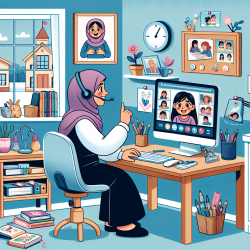Introduction
In the realm of speech-language pathology and online therapy services, understanding the environment in which adolescents live can significantly impact therapeutic outcomes. The research article "How adolescents perceive their communities: a qualitative study that explores the relationship between health and the physical environment" provides valuable insights into how adolescents perceive their physical environment and its impact on their health. This blog post will explore how practitioners can enhance their skills by implementing the findings of this study and encourage further research into this critical area.
Key Findings of the Study
The study conducted in five cities—Baltimore, Ibadan, Johannesburg, New Delhi, and Shanghai—revealed that adolescents perceive their physical environment as a significant factor influencing their health. The research identified five primary aspects of the physical environment that adolescents believe impact their health:
- Perception of Safety: Adolescents across all sites expressed concerns about safety, with vacant homes and lack of street lighting contributing to feelings of insecurity.
- Dirt and Pollution: Garbage, pollution, and poor sanitation were common themes affecting adolescents' health perceptions, particularly in Shanghai and New Delhi.
- Housing: Overcrowded and decaying housing conditions were highlighted as detrimental to health, especially in Baltimore and Johannesburg.
- Recreational Spaces: Limited access to safe recreational spaces was a concern, impacting physical and mental well-being.
- Infrastructure: Lack of basic infrastructure, such as electricity and water, was noted in Ibadan and New Delhi.
Implications for Practitioners
Understanding these environmental factors can help practitioners tailor their therapeutic approaches to better meet the needs of adolescents. Here are some strategies for practitioners:
- Incorporate Environmental Context: During assessments, consider the adolescent's physical environment and its potential impact on their health and communication abilities.
- Advocate for Safe Spaces: Work with schools and communities to create safe and accessible recreational spaces for adolescents.
- Promote Health Literacy: Educate adolescents about the impact of their environment on health and empower them to advocate for improvements.
- Collaborate with Community Stakeholders: Engage with local organizations and policymakers to address environmental issues affecting adolescent health.
Encouraging Further Research
The study highlights the need for further research into the relationship between the physical environment and adolescent health. Practitioners can contribute to this research by documenting environmental factors observed during therapy sessions and sharing findings with the broader research community.
Conclusion
By understanding and addressing the environmental factors impacting adolescent health, practitioners can enhance their therapeutic outcomes and contribute to the well-being of young people. To delve deeper into the findings, practitioners are encouraged to read the original research paper.
To read the original research paper, please follow this link: How adolescents perceive their communities: a qualitative study that explores the relationship between health and the physical environment.










